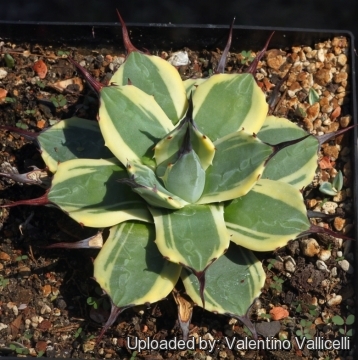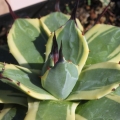Accepted Scientific Name: Agave applanata cv. Cream Spike

Agave applanata cv. Cream Spike (Agave patonii ''variegata'' or Agave parry cv. Merico Nishiki)
This variegated form is especially attractive and it is always one those plants that caught peoples eyes in the green house. It look like a giant artichoke with somewhat wide, short pale blue leaves margined with cream coloured edges and a dark-red, sharp terminal spine and small, but very sharp reddish lateral leaf spines. The handsome smaller rosette will not exceed 15 cm in diameter and is therefore ideal for growing in containers.
Origin and Habitat: Garden origin (Nursery selected cultivar). Randy Baldwin at San Marcos Growers in Santa Barbara, Califor-nia, has indicated that Rick Nowakowski at Nature's Curiosity Shop received this plant from Japan in the 1980s, but the original source of the form is still a mystery.
Synonyms:
See all synonyms of Agave applanata
back
Accepted name in llifle Database:Agave applanata Lem. ex JacobiHamburger Garten- Blumenzeitung 20: 550 1864Synonymy: 4
Cultivars
(1):
back
Description: Agave applanata cv. Cream Spike, long misrepresented in horticulture as as Agave patoniiSN|530]] ''variegata'' is the dwarf, small growing, variegated form of Agave applanataSN|29328]]SN|242]]. It is highly ornamental and quite popular as a container plant, but there are many that don't believe this plant to be a cultivar of Agave applanataSN|530]]SN|242]] and still continue to consider it a cultivar of Agave parryiSN|247]]SN|247]]. It is highly dimorphic, with a low-growing, almost flat juvenile form, before making a rounded rosette with very stiff more erect leaves as it ages. This cultivar is also found under a few different names like:Agave patoniiSN|242]]SN|530]] f. marginata alba or 'alba marginata', Agave patoni f. variegataSN|242]]SN|29328]] , or with the Japanese names Agave patoniiSN|530]]parry cv. Merico Nishiki|SN|535]] , or 'Ohikitsusyote Nisiki' or 'Toyoushi'. Other names include: Agave minima 'Variegata'. This cultivar is indeed quite variable, this may suggests that there is more than one clone in culture, however growing condition (exposition, water, soil, pot size, feeding etc.) and age of the plant, greatly influences the habit, colour and sizes of its leaves and spines. It shoots off pups/offsets readily as the mother plant matures.
Stem: Acaulescent.
Juvenile form:Rosettes, larger than tall when young, usually only 10-12 cm tall by about 15-25 (or more) cm wide.
Adult form Rosettes, compact, looking like giant artichokes, eventual size of the rosette is unknown, with the largest ones having reached 30-40 cm tall and about 60 cm in diameter.
Leaves: Essentially smooth light blue-grey-green to olive green, very broadly oblong, quickly acuminate, openly concave (spoon-shaped), margined with cream coloured edges and with a stiffly erect-spreading; spine somewhat flexuous (becoming firm in mature specimen) , from purple-chestnut becoming dull grey-brown. The margins occasionally have a seasonal slight flush of red at the leaf tip and base. Marginal spines are well spaced.
Flowers: Blooms only when the plant is 20 years old or more. The flower stalk is up to 3 (or more) meters tall with small orange to yellow flowers. The plant then dies leaving suckers that grow into replacement plants.
Subspecies, varieties, forms and cultivars of plants belonging to the Agave applanata group
 Agave applanata Lem. ex Jacobi: has very close rosettes 0,5-1(-1,8) m tall, 1-2 m in diameter. Distribution: Veracruz and adjacent Puebla (Mexico)
Agave applanata Lem. ex Jacobi: has very close rosettes 0,5-1(-1,8) m tall, 1-2 m in diameter. Distribution: Veracruz and adjacent Puebla (Mexico) Agave applanata cv. Cream Spike: is adwarf, small growing, variegated form with light blue-grey-green to olive green, leaves, with cream coloured edges and erect-spreading central spines.
Agave applanata cv. Cream Spike: is adwarf, small growing, variegated form with light blue-grey-green to olive green, leaves, with cream coloured edges and erect-spreading central spines.
Bibliography: Major references and further lectures
1) Greg Starr “Agaves: Living Sculptures for Landscapes and Containers” Timber Press, 27/Jun/2013
2) San Marcos Growers contributors “Agave 'Cream Spike' - Cream Spike Agave ” San Marcos Growers <http://www.smgrowers.com>. Web. 27 Sep. 2014.
3) Howard Scott Gentry “Agaves of Continental North America” University of Arizona Press, 01/Feb/2004
4) Park S. Nobel “Environmental Biology of Agaves and Cacti” Cambridge University Press, 16/Oct/2003
 Agave patoni f. variegata (Agave applanata cv. Cream Spike) Photo by: Viviana Alejandra Castro
Agave patoni f. variegata (Agave applanata cv. Cream Spike) Photo by: Viviana Alejandra Castro Agave patoni f. variegata (Agave applanata cv. Cream Spike) Photo by: Valentino Vallicelli
Agave patoni f. variegata (Agave applanata cv. Cream Spike) Photo by: Valentino Vallicelli Agave patoni f. variegata (Agave applanata cv. Cream Spike) Photo by: Valentino Vallicelli
Agave patoni f. variegata (Agave applanata cv. Cream Spike) Photo by: Valentino Vallicelli Agave patoni f. variegata (Agave applanata cv. Cream Spike) Photo by: Cactus Art
Agave patoni f. variegata (Agave applanata cv. Cream Spike) Photo by: Cactus Art Agave patoni f. variegata (Agave applanata cv. Cream Spike) Photo by: Cactus Art
Agave patoni f. variegata (Agave applanata cv. Cream Spike) Photo by: Cactus Art Agave patoni f. variegata (Agave applanata cv. Cream Spike) Photo by: Viviana Alejandra Castro
Agave patoni f. variegata (Agave applanata cv. Cream Spike) Photo by: Viviana Alejandra Castro Agave patoni f. variegata (Agave applanata cv. Cream Spike) Photo by: Valentino Vallicelli
Agave patoni f. variegata (Agave applanata cv. Cream Spike) Photo by: Valentino Vallicelli Agave patoni f. variegata (Agave applanata cv. Cream Spike) Photo by: Valentino Vallicelli
Agave patoni f. variegata (Agave applanata cv. Cream Spike) Photo by: Valentino VallicelliCultivation and Propagation: Agave applanata cv. Cream SpikeSN|529]]SN|529]] is a stunning specimen plant for containers the distinguishing feature of which lies in the variegated leaves. It tend to be slow grower, but worth the effort.
Growth rate: The growth rate is quite slow, especially when grown as a miniature in a container, and it will take many years to achieve full size.
Soil: Grow it in porous soil with adequate drainage.
Exposure: It do well in full sun or a lightly shaded area, but prefers some shade in hot climates.
Moisture: Water thoroughly when soil is dry to the touch. In winter watering this plant can be done once every 1-2 months, there is no need to mist the leaves.Warning too much water can cause leaves to rot.
Pests and diseases: No serious insect or disease problems.Watch out for rodents! This is one that they seem to relish, and they can ravage a young plant overnight. Stem or root rots can be a problem in wet soils.
Hardiness: Plants have proven hardy to at least -7 to -8 C and should probably be able to withstand slightly lower temperatures. USDA zones 8b-11.
Propagation: Relatively easy to propagate by suckers. Young plants produce copious quantities of pups which are easily pulled and re-planted elsewhere. Remove the basal suckers in spring or summer and let the cuttings dry for a few days before inserting in compost. The only problem is the logistics of getting to the suckers, very sharp spines and suckers usually right up against, or underneath the mother plant.
Your Photos

by Valentino Vallicelli

by Cactus Art

by Valentino Vallicelli

by Valentino Vallicelli






















